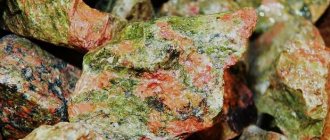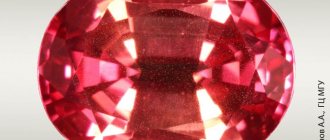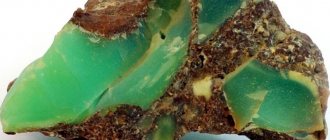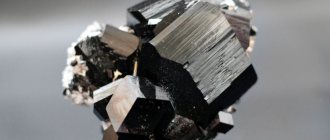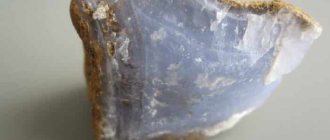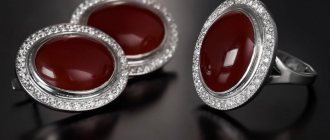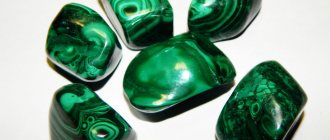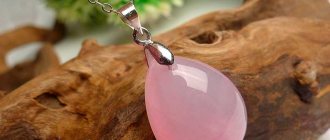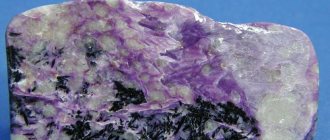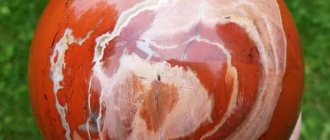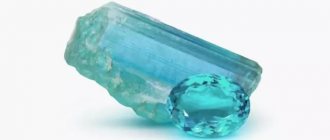This amazingly beautiful and very rare gem was discovered only in 1987. Paraiba is a truly precious stone, because one carat costs at least 10 thousand dollars.
The greenish-blue gem does not cast a shadow even on a sunny day. Instead, a neon glow appears, emanating from the stone.
History and origin of the name
The stone was originally called heiterite in honor of its discoverer.
In Brazil, illegal treasure miners are called "garimpeiros." One of them, Hayter Barbosa, had the honor of finding a new gem. This was no ordinary garimpeiros. He did not thirst for profit, like everyone else. He was driven by the dream of finding something that would glorify Brazil.
Having purchased a license to search for precious stones in the easternmost Brazilian state of Paraibo, he, along with a group of the same prospectors, practically did not leave the adits of an abandoned mine near the village of São José da Batalha for five years, sifting through tens of tons of rocks in the hope of finding something quite unusual.
His dream came true in 1987, when Barbosa himself was already terminally ill. During excavations of a 60-meter-high hill, a strikingly beautiful tourmaline was discovered, glowing from the inside with blue neon light. Hayter himself missed the triumphant exhibition in the Arizona city of Tucson, where the price of the new gem increased tenfold in a matter of days.
And yet, for some reason, the name “hayterite” did not stick, and the stone was called “Paraiba” after the name of the Brazilian state where it was first found. In general, it turned out as Hayter dreamed, who glorified his country with his find.
Applications
In jewelry, the incredibly beautiful and unique Paraiba is incredibly popular. Its ability to polarize light increases when the stone is cut, which it lends itself well to due to its high hardness. Paraiba is used as inserts in a wide variety of jewelry and is classified as an expensive precious stone.
Place of Birth
The hill where the unusual mineral was found was torn down very quickly, since the price per carat was ten times higher than that of diamonds. Quite a lot of stones were mined, but the largest of them did not exceed 8 carats.
After the first deposit was depleted in 2001, similar gems were found in Nigeria, and then in Mozambique, Tanzania and Madagascar. But African gems were significantly inferior to Brazilian ones in terms of jewelry quality, differing from them in shades and intensity of glow. Until now, jewelers do not recognize them as real Paraiba, and their price is ten times less.
Despite this difference, the composition of stones from different shores of the Atlantic is almost identical, and the age of the gems is the same, since they were formed about 500 million years ago in the depths of the ancient continent of Pangea. Pangea later split into several parts, now separated by thousands of kilometers of ocean.
But recently, already in the 21st century, it was possible to find another deposit in Brazil, but in a different state of Rio Grande do Norte. Their quality was the same as those opened by Hayter. Since then, only the Brazilians call it “paraiba”, while the African ones only call it “paraiba type”.
Paraiba tourmaline
The exorbitant cost of the mineral Paraiba tourmaline has given rise to a wave of experiments. They were taken up by both scientists and amateur “alchemists”.
Traditional manufacturing methods
The most common methods:
- Heat green tourmaline to 600°C. The stone turns blue, but the neon effect disappears.
- Use copper electrophoresis. Copper penetrates shallowly into the green stone; any scratch reveals the imitation.
- Heat purple tourmaline for a long time in an acidic environment. The stone will become discolored, but the green reflection turns out to be “brutal” and is visible only on the upper layers. This is detected under a microscope.
- Heat the same violet sample, then irradiate it. The effect is achieved quickly; only special equipment can detect a fake.
Only a nuclear accelerator can be guaranteed to “impregnate” an entire stone with copper. However, the procedure is not cost-effective.
Nanotechnology
A more modern, cheaper method is the use of nanotechnology. China is the first on the market for this position.
Companies in the country offer products for less than $10 per jewelry insert. The origin is disclosed in the product description, indicating the material as “Nano gemstones, created in a laboratory.” Dimensions are metric (eg 10mm diameter) and not carat.
The nano sample looks like natural Paraiba in good condition.
Physical properties
Paraiba is a variety of tourmaline and has the same physical properties. Their shine is glassy. The refractive index is close to glass (1.62-1.65), and the density is 3.2 g/cm3. The hardness is quite high and ranges from 7 to 7.5. The color can be sky blue or greenish blue. In African stones, a green tint is much more common, as are pink or purple.
The glow of Paraiba is due to the property of tourmalines to polarize passing light. As a result of multiple reflections of polarized rays, a magical glow is born.
Interesting: Paraiba, like other tourmalines, exhibits piezo- and pyroelectric effects, that is, the ability to acquire a potential difference at the ends of the crystal under the influence of deformation and heating.
Chemical properties and composition
In terms of its chemical composition, Paraiba is a boron- and fluorine-containing aluminosilicate. Its color is given by numerous impurities, primarily copper and manganese, and it is copper that provides the sky-blue color of the stone, and manganese spoils it, imparting pink and purple tones, as in the African “Paraiba type”. Copper in a quality stone should be at least 1.2%. In total, about 50 elements were found in Paraiba. This is one of the richest gems in composition.
Paraiba is quite resistant to acids and alkalis. Only molten alkalis are capable of dissolving it, and even then very slowly. But the color and glow may change from contact with chemicals. They are determined by very subtle ratios of the components included in the stone.
Artificial paraiba
As soon as the price of Paraiba exceeded $10,000 per carat, attempts to counterfeit the gem became more frequent. This turned out to be a very difficult task. It is possible to obtain a neon glow throughout the entire volume of a transparent stone only if there is a sufficient copper content inside it. They tried to saturate the surface layer with copper, but such fakes were immediately noticeable by the nature of the glow.
There have been attempts to produce sky blue from purple or pink Africans by heating. The color came out, but the shine disappeared. Great results were achieved by those who combined the heating of indigolites in acids with harsh gamma irradiation. Such stones can only be distinguished by chemical analysis.
The only way to get an analogue was to fire copper atoms at an accelerator, but this is already exotic, although raising the price a little more would pay off.
The Swarovski company also makes similar ones to Paraiba, but the composition of the crystals is completely different; they are glass-ceramics. Despite the great similarity to natural Paraiba, according to esotericists, such counterfeits do not have magical or healing properties.
Decorations
Every piece of jewelry with Paraiba tourmaline is doomed to success. World-famous jewelry houses such as Dior, Tiffany, Spark Creations, etc. know this and actively use it. Jewelry with a famous gem looks great framed in yellow or white gold and in combination with diamonds, as well as colorful precious stones, such as sapphires or emeralds.
Tiffany
Tiffany & Co has exclusive purchasing authority for all neon gems over 3 carats. She bought more than 70% of Paraiba tourmalines, and then organized a project to promote her jewelry with this stone and in 5 years had already earned more than 100 million US dollars.
The natural gemstone Paraiba tourmaline is used only in luxury jewelry, often created in a single copy to order, and is sold at exorbitant prices. But it is worth it, which becomes obvious at one glance at its magical hypnotic glow and unique heavenly purity.
Review of Paraiba tourmaline at the exhibition:
How to spot a fake
Even an experienced jeweler will have difficulty distinguishing a particularly high-quality fake. There are also Swarovski crystals with the right neon glow. They are as hard as natural stone and cannot be scratched by a key. But you can try to scratch cheap glass fakes. If the jeweler is afraid of such a procedure, then this is a sure sign that he is trying to pass one thing off as another.
With a needle you can also check a gem that has been heated in acid, following the greenish trace.
Colors
Paraiba tourmaline is distinguished by its bright, rich blue-turquoise color, which is no longer found in nature.
Once cut, even in low light, the mineral specimen exhibits a beautiful play of color, giving it a neon or electric appearance. The natural color of Paraiba can be artificially enhanced by annealing. After this procedure, the crystals become very rich and bright. So, blue and green Paraibas are very popular. But natural specimens of purple and red color, which contain an admixture of manganese, are discolored using heat treatment.
Magic properties
Paraiba is credited with the magical property of relieving feelings of melancholy and anxiety. This stone helps to find your soulmate, protects against negative energy, and gives interesting ideas to creative people. It relieves fatigue and gives confidence in one's own abilities.
Paraiba is useful for all those who experience constant stress and nervous overload, or suffer from troubles in the family, as it has a calming effect.
Who is suitable according to their zodiac sign?
Paraiba tourmalines are suitable for all zodiac signs. The properties of these gems appear depending on their belonging to the zodiac element:
- Pisces, Cancers and Scorpios are considered favorites of this stone. It helps representatives of these signs curb their emotions, become more restrained and balanced.
- Virgos, Capricorns and Taurus can use paraiba for medicinal purposes, to relieve physical and emotional fatigue.
- Leos, Sagittarius and Aries will receive an inexhaustible supply of energy and inspiration from the mineral.
- With the help of the stone, Libra, Aquarius and Gemini will be able to reveal their creative talent and hidden abilities.
When choosing Paraiba tourmaline as a talisman or amulet, you should be guided by your own feelings. If during contact with the stone you feel a surge of strength and your mood improves, then it is energetically suitable.
Medicinal properties
This neon glowing stone is believed to be:
- Normalizes blood pressure;
- Improves the functioning of the endocrine system;
- Cures women's diseases;
- Calms the nervous system;
- Protects against ARVI;
- Slows down aging.
ATTENTION: The stone is contraindicated for diseases of the thyroid gland. It should be worn with caution if you are pregnant or breastfeeding, or if you have a fever. Signs of incompatibility are sudden weakness and melancholy when wearing the stone.
Paraiba products
Paraiba is set into brooches, pendants and earrings, often surrounded by diamonds to highlight its blue radiance. All the richness of the glow can be seen in white gold rings.
Such a ring can cost up to hundreds of thousands of dollars or even more.
Interesting: The most expensive Paraiba was sold for $125 million and entered the Guinness Book of Records.
PRICE DYNAMICS.
In the last decade, the price of Paraiba tourmalines has shown rapid growth.
If in the early 90s 1 carat of a stone was sold for 250 US dollars, now its cost per carat can exceed 20,000 US dollars. It is Paraiba tourmaline that the stone market owes to the fact that the concept of precious and semi-precious minerals was revised. Before the appearance of this stone on sale, it was believed that only representatives of the “Big Four” were considered investment stones: diamond, ruby, sapphire and emerald. Today these boundaries no longer exist. Interesting information:
Diamond earrings accented with Paraiba tourmalines weighing 7.46 and 6.81 carats at the Hong Kong Christie's auction held on May 29, 2018, were sold for 2.78 million US dollars.
Stone care
Paraiba is washed only with warm running clean water. The use of any chemicals is unacceptable.
Store separately from diamonds, rubies and sapphires, which can scratch Paraiba.
Staying in sunlight causes the glow to decrease.
This stone is not available to every fashionista; it is not for nothing that the paparazzi sometimes hunt for stars just to look at Paraiba jewelry. Even those who can afford to purchase diamonds can buy African “Paraiba-type” diamonds. But the stone is worth it!
Where is it used?
The main areas of application of Paraiba tourmaline:
- Jewelry making. Faceted tourmaline stones are framed in gold and platinum and displayed in premium jewelry collections.
- Collecting. Collectors hunt for raw Paraiba crystals, regardless of the deposit. They are ready to pay significant sums for this mineral.
- Investments. Deposits of this variety of tourmaline are drying up, which leads to its rapid rise in price. The annual increase in the cost of Paraiba ranges from 20 to 30%.

